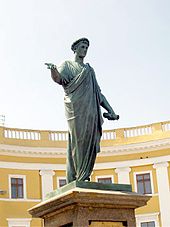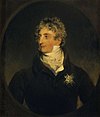Armand Emmanuel de Vignerot du Plessis, 5th Duke of Richelieu
Marquis Dessolles | |
|---|---|
| Member of the Académie française | |
| In office 23 March 1816 – 17 May 1822 | |
| Preceded by | Antoine-Vincent Arnault |
| Succeeded by | Bon-Joseph Dacier |
| Governor of Odesa | |
| In office 8 October 1803 – 27 August 1814 | |
| Monarch | Alexander I |
| Preceded by | Paul Pustoshkin |
| Succeeded by | Thomas A. Cobley |
| Personal details | |
| Born | Armand Emmanuel Sophie Septimanie Vignerot du Plessis 25 September 1766 Paris, France |
| Died | 17 May 1822 (aged 55) Paris, France |
| Political party | Doctrinaires |
| Spouse | |
| Profession | |
| Years of service | 1785–1814 |
| Rank | Captain Major general |
| Unit | Dragoon 3rd Hussar Regiment |
| Battles/wars |
|
Armand Emmanuel Sophie Septimanie de Vignerot du Plessis, 5th Duke of Richelieu and Fronsac (25 September 1766 – 17 May 1822), was a French statesman during the Bourbon Restoration. He was known by the courtesy title of Count of Chinon until 1788, then Duke of Fronsac until 1791, when he succeeded his father as Duke of Richelieu.
As a royalist, during the French Revolutionary Wars and Napoleonic Wars, he served as a senior officer in the Imperial Russian Army, achieving the grade of major general. Following the Bourbon Restoration, he returned to his homeland and was twice Prime Minister of France.
Early years
He was born in
Known by the courtesy title of comte de Chinon during the lifetime of his distinguished grandfather, he was married on 4 May 1782 at the age of fifteen to Alexandrine Rosalie Sabine de Rochechouart-Faudoas (13 December 1768 – 9 December 1830),[1] a hunchbacked child of fourteen. Immediately after the wedding, Chinon embarked upon the Grand Tour with his tutor, visiting the cities of Geneva, Florence and Vienna. Because of Rosalie's deformity, it is unlikely the marriage was ever consummated. During their long marriage, which was often punctuated with periods of extended separation, the two were never more than formal with each other.[2]
After three years of foreign travel, he entered Queen
By 1789, he was a captain in the Esterhazy Regiment of
Exile
On Marie Antoinette's direction, he left Paris in 1790 for Vienna to discuss the recent events of the
On the death of his father in February 1791, he succeeded to the title of Duke of Richelieu. Because of an unwillingness on the part of various nobles to serve in the royal household, King Louis XVI soon afterwards summoned him back to Paris in order for him to resume his position as a premier gentilhomme at the Tuileries Palace. He was not, however, sufficiently in the confidence of the court to be informed of the projected flight to Varennes on the night of 20 June 1791.[2]

Feeling that his role at court was useless in helping the King deal with all the revolutionary agitation that was embroiling Paris, Richelieu in July obtained with royal permission a passport from the National Constituent Assembly in order to return to Vienna as a diplomat. After a short stay in Austria, however, Richelieu joined the counter-revolutionary émigré army of Louis XVI's cousin, the Prince of Condé, which was headquartered in the German frontier town of Koblenz. Later, after Condé's forces had suffered several defeats, Catherine the Great offered positions in her army to the officers serving under Condé. Richelieu accepted.
In the Russian army, he achieved the rank of
Return to France
Richelieu returned to France in 1814. On the return of Napoleon from Elba, he accompanied Louis XVIII as far as Lille. From there, he chose to return to Vienna in order to rejoin the Russian army, believing that he could best serve the interests of the new king and of France by attaching himself to the headquarters of Tsar Alexander.[2]
Richelieu's character and antecedents alike marked him out as a valuable support for the monarchy at the beginning of the
It was mainly due to his efforts that France was so quickly relieved of the burden of the Allied army of occupation. In order to achieve this goal, he attended the
He died, of a stroke, on 17 May 1822.[11]
Notes
This article includes a list of general references, but it lacks sufficient corresponding inline citations. (December 2017) |
- ^ Alexandrine Rosalie Sabine DE ROCHECHOUART in: geneanet.org [Retrieved 9 November 2014].
- ^ a b c d e f g h Chisholm 1911, p. 302.
- ^ a b Cynthia Cox, Talleyrand's Successor, London (1959) p.30
- ^ Antonia Fraser, Marie Antoinette, The Journey, New York (2001) p.296
- ^ Travels in Russia, and a residence at St. Petersburg and Odessa, by Edward Morton
- ^ Odessa, 1812: Plague and Tyranny at the Edge of the Empire
- ^ Migration and Disease in the Black Sea Region by Andrew Robarts, p. 148
- ^ Chuquet, Arthur (1909). Recollection of Baron de Frénilly: Peer of France (1768-182). London: W. Heinemann. p. 300.
- ISBN 978-1-108-84206-8.
- ISBN 978-0-691-23015-3.
- ^ Chisholm 1911, p. 303.
References
- Chisholm, Hugh, ed. (1911). . Encyclopædia Britannica. Vol. 23 (11th ed.). Cambridge University Press. pp. 302–303.
- Cynthia Cox, Talleyrand's Successor, London (1959) Amazon.com
- Antonia Fraser, Marie Antoinette, The Journey, New York (2001) Amazon.com
- A great part of Richelieu's correspondence with Capo d'Istria and others, with his journal of his travels in Germany and the Turkish campaign, and a notice by the duchesse de Richelieu, is published by the Imperial Russian Historical Society, vol. 54.
- There is an exhaustive study of his career by Léon de Crousaz-Crétet, Le Duc de Richelieu en Russie et en France (1897), with which compare an article by L. Rioult de Neuville in the Revue des questions historiques (Oct. 1897)
- See also R. de Cisternes, Le Duc de Richelieu, son action aux conférences d'Aix-la-Chapelle (1898), containing copies of documents.

